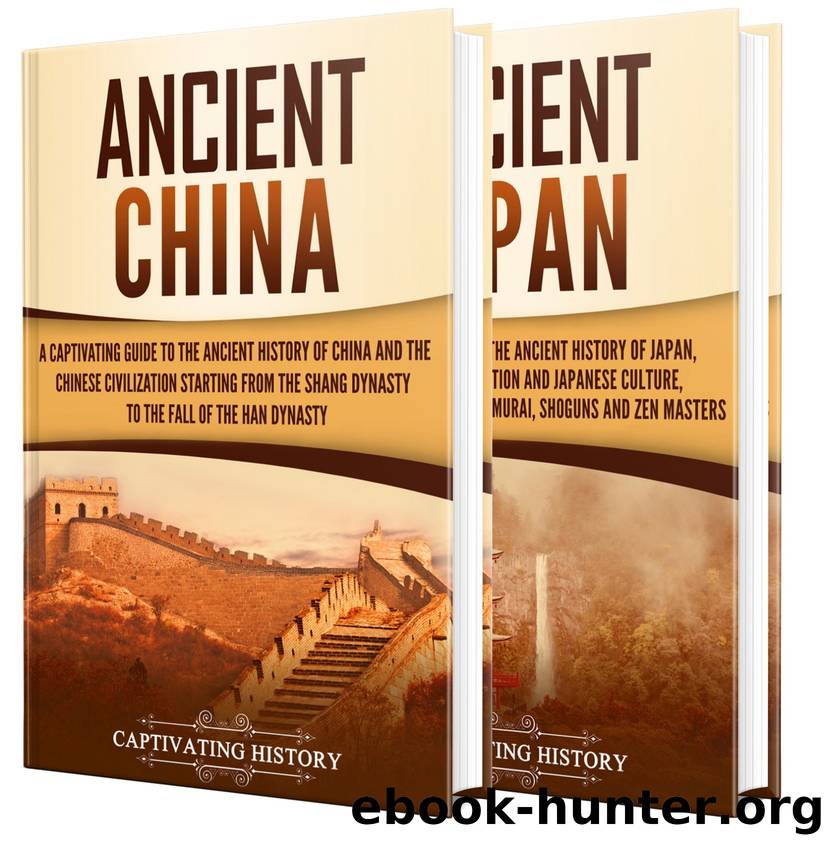Ancient Asian History: A Captivating Guide to the Ancient Civilizations of China and Japan by Captivating History

Author:Captivating History [History, Captivating]
Language: eng
Format: azw3
Published: 2020-05-03T16:00:00+00:00
A jar from the Yayoi period. Source: https://commons.wikimedia.or g
This was further emphasized by the rise of trade between the tribes. Some were settled in the regions that had metal ores, which are rather scarce in Japan, while others had agricultural surpluses or produced silk (technology which was also imported from China), pottery, glass, or metal products. But the trade remained in the hands of the wealthiest, further elevating them from the commoners. With that, society changed as well. Tribes developed into more territorial chiefdoms, with warfare escalating between them in a fight to control vital territories. Warfare was the final element that solidified the position of the elites as they were the only ones capable of both wielding metal weapons and gathering large forces to wage wars. At the same time, prisoners were becoming slaves, creating the lowest social class, although it never became as influential as it was in ancient Rome or Greece. This social stratification was an important change, ending the previously more egalitarian community. And as warfare continued, chiefdoms started to ally with one another, growing through conquest and creating a large number of rather small political communities which we today identify as kingdoms. Their power also grew which became evident by the fact that by the late 1st century CE, they were capable of sending envoys to the Chinese empire, looking for an external ally in one of the strongest world powers of the time.
These connections with the already fully developed Chinese civilization leaves us with some rare detailed glimpses into Japanese history, as the Chinese historians of that era wrote about Japan as well. At first, they called it the land of Wa, meaning land of dwarfs, and they noted that it consisted of 100 small kingdoms. By the mid-3rd century, Chinese writers give us more detailed looks, describing in more detail Yamatai (Hsieh-ma-t'ai in Chinese) as the strongest of the Japanese kingdoms. They report this kingdom was ruled by Queen Himiko, a female shaman and a strong figure which was recognized by the Chinese as the ruler of the entirety of Japan, though it is unclear if her influence was that strong. She supposedly lived secluded in a fortress, served by 1,000 women and 1 man, guarded by 100 soldiers, and accessible only to her brother, who dealt with the day-to-day state affairs. Chinese reports tell us that Himiko herself was involved with magic and sorcery and that she remained unmarried. She ascended to the throne after a long period of wars in Japan around 180 CE, and she ruled until her death in 248 CE, which afterward Yamatai fell once again into turmoil. Reportedly, a king was chosen, but no one wanted to obey him, so a new queen, 13-year-old Iyo, who was Himiko’s relative, was picked as a new ruler.
These details, like the exact location of Yamatai which some scholars place in northern Kyushu or central Honshu, are marked with a dose of uncertainty, as no other evidence of them have been found.
Download
This site does not store any files on its server. We only index and link to content provided by other sites. Please contact the content providers to delete copyright contents if any and email us, we'll remove relevant links or contents immediately.
| Africa | Americas |
| Arctic & Antarctica | Asia |
| Australia & Oceania | Europe |
| Middle East | Russia |
| United States | World |
| Ancient Civilizations | Military |
| Historical Study & Educational Resources |
The Alienist by Caleb Carr(1550)
The Analects of Confucius by Burton Watson(1151)
On China by Henry Kissinger(1130)
China in Ten Words by Yu Hua(999)
The Last Kings of Shanghai by Jonathan Kaufman(979)
One Bright Moon by Andrew Kwong(883)
Deng Xiaoping and the Transformation of China by Vogel Ezra F(851)
Mao's Last Dancer by Li Cunxin(829)
Midnight in Peking by Paul French(807)
Three Tigers, One Mountain by Michael Booth(805)
Seven Years in Tibet by Heinrich Harrer(798)
The Snakehead: An Epic Tale of the Chinatown Underworld and the American Dream by Patrick Radden Keefe(798)
Big Sister, Little Sister, Red Sister by Jung Chang(749)
Tiger Trap by David Wise(706)
Ancient Chinese Warfare by Ralph D. Sawyer(688)
Modern China. A Very Short Introduction by Rana Mitter(648)
The Open Road by Pico Iyer(639)
Chinese Theology by Chloë Starr(633)
Riding the Iron Rooster by Paul Theroux(623)
